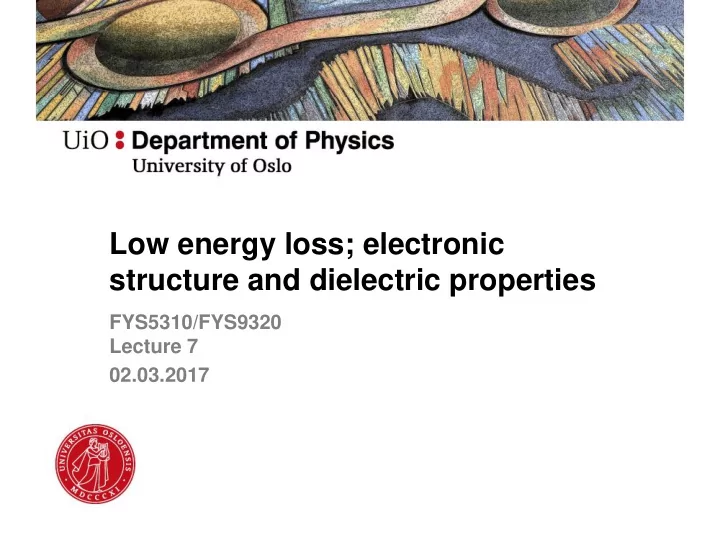

Low energy loss; electronic structure and dielectric properties FYS5310/FYS9320 Lecture 7 02.03.2017
FYS5310 teaching schedule Preliminary schedule only! You should keep the class-times on Wednesdays and Thursdays open unless notified by email (or in this schedule) that there is no class References to the textbook to Fultz & Howe unless stated otherwise. Date Time Lecture/lab Topic Chapters Homework Wednesday 18.01.2017 14:15-16:00 Lecture Introduction to the course. Derivation of the structure factor (01) 4.1, 4.3.1, 6.1 Exercise set 1 (handout) Thursday 19.01.2017 12:15-14:00 Lecture No class (SMN seminar) Wednesday 25.01.2017 13:15-16:00 Lab/Colloquium Going through exercise set 1 + Lecture: The atomic form factor (02) 4.3 Excercise set 2 (handout) Thursday 26.01.2017 12:15-14:00 Lecture No class Wednesday 01.02.2017 14:15-16:00 Lab/colloquium Going though exercise set 2 Thursday 02.02.2017 12:15-14:00 Lecture Uses of EELS and EELS instrumentation (03) 5.1, 5.2; W&C 37 Exercise set 3 (handout) Wednesday 08.02.2017 14:15-16:00 Lab/colloquium Going though exercise set 3 5.4.1-5.4.3 + primer on Dirac notation Thursday 09.02.2017 12:15-14:00 Lecture Inelastic form factors (04) Wednesday 15.02.2017 12:15-16:00 Lab/colloquium No class 5.4.4-5.4.7, W&C 39, plus Brehm and Mullin on parity Inelastic form factors, scattering cross sections, dipole selection and dipole Thursday 16.02.2017 12:15-14:00 Lecture rules (05) selectrion rules Wednesday 22.02.2017 12:15-16:00 Lab/colloquium No class Thursday 23.02.2017 12:15-14:00 Lecture Core losses: Quantification and electronic structure (06) 5.4, W&C 39+40 Exercise set 4 (handout) Wednesday 01.03.2017 12:15-16:00 Lab/colloquium Going through excercise set 4 Low energy loss; electronic structure and dielectric properties pt 1 Thursday 02.03.2017 12:15-14:00 Lecture (07) 5.3, W&C 38 Exercise set 5 (handout) Wednesday 08.03.2017 12:15-16:00 Lab/colloquium Computer lab + going through exercise set 5 Low energy loss; electronic structure and dielectric properties pt 2 Thursday 09.03.2017 12:15-14:00 Lecture (08) 5.3, W&C 38 Wednesday 15.03.2017 12:15-16:00 Lab/colloquium No class Thursday 16.03.2017 12:15-14:00 Lecture No class Wednesday 22.03.2017 12:15-16:00 Lab/colloquium Computer lab 2
• If the initial states are sharply peaked in energy, then all transitions originate at this energy • One particular E i and one particular E takes you to a single point in the conduction band E f • In effect we are convoluting the conduction band DOS with a delta function 𝐸𝑓𝑚𝑢𝑏 𝑔𝑣𝑜𝑑𝑢𝑗𝑝𝑜 ⊗ 𝑑𝐸𝑃𝑇 = 𝑑𝐸𝑃𝑇 • The spectrum reflects a scaled conduction band DOS 𝑤𝐸𝑃𝑇 ⊗ 𝑑𝐸𝑃𝑇 =? • But what if the initial states are in the valence band? 3
Possible transitions contributing to one point in the energy loss spectrum E Density of states Binding energy 4
These E transitions are not allowed Density of states Binding energy 5
…still no contribution to the EELS spectrum E Density of states Binding energy 6
What about now? E Density of states Binding energy 7
Here we see the first transition that contributes to the EELS spectrum E Density of states Binding energy 8
And this is the final transition that contributes Repeat for the next energy loss E E Density of states Binding energy 9
The EELS spectrum as a Joint Density of States This is good for core losses: But for single electron transitions in the low loss region we need to consider the convolution of valence DOS with conduction DOS (also called Joint Density of States, JDOS): 𝜁 𝐺 2 𝜍 𝑤𝑐 𝐹 𝑗 𝜍 𝑑𝑐 𝐹 𝑗 + 𝐹 𝑒𝐹 𝑗 𝑔 𝑓 𝑗𝒓⋅𝒔 Ψ 𝑗 𝐽(𝐹) ∝ Ψ 𝜁 𝐺 −𝐹 No dipole approximation? 10
• The low loss spectrum can be used to detect band gaps and so- called critical points in the JDOS. • These features are very important for optical properties 11
12 Yu & Cardona
The dielectric fuction • Describes the response of the material to an external field • Not a constant 𝜁 𝜕 = 𝜁 1 𝜕 + 𝑗𝜁 2 (𝜕) • The real term describes the polarizability • The imaginery term describes absorption • The «single scattering distribution» is given by 2 2𝐽 0 𝑢 1 𝛾 𝐽 𝐹 = 𝜌𝑏 0 𝑛 0 𝑤 2 𝐽𝑛 − ln 1 + 𝜁 𝐹 Θ 𝐹 1 𝜁 2 𝐽𝑛 − = 2 2 + 𝜁 2 𝜁 𝐹 𝜁 1 13
14
The dielectric polarization of the material The polarization of a material subjected to a time warying electric field is: 𝑸 𝜕 = 𝜁 0 𝜁 𝜕 − 1 𝑭(𝜕) The displacement (total field) in the material is then: 𝑬 𝜕 = 𝜁 0 𝑭 𝜕 + 𝑸 𝜕 = 𝜁 0 𝑭 𝜕 + 𝜁 0 𝜁 𝜕 − 1 𝑭 𝜕 = 𝜁 𝜕 𝜁 0 𝑭(𝜕) So what happens if 𝜁 𝜕 =0? 15
The dielectric function in the Drude model • For free electrons in a uniform background potential, the dielectric fuction is 2 𝜕 𝑞 𝜁 𝜕 = 1 − 𝜕 + 𝑗𝜕/𝜐 Where 𝜕 𝑞 is a harmonic • oscilator resonance frequency given by 𝑜𝑓 2 𝜕 𝑞 = 𝑛 0 𝜁 0 • 𝜐 is the scattering time/damping factor 16
17
18
19
𝑜𝑓 2 𝜕 𝑞 = 𝑛 0 𝜁 0 20
21
Dielectric function, refractive index, speed of light • The real part of the dielectric fuction gives the refractive index n= • The refractive index gives the phase velocity of light in the material c=c 0 /n . • This is lower than the speed of light in vacuum n Si ( 600 nm, E 2 eV) 4 𝑑 0 𝑑 𝑇𝑗 = 𝑜 𝑇𝑗 ≈ 0,25 𝑑 0 𝑤 𝑓 (200 𝑙𝑊) ≈ 0,7 𝑑 0
Problems for next time 23
Recommend
More recommend